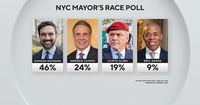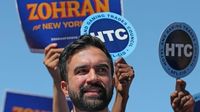With just weeks remaining before New Yorkers head to the polls, the city’s mayoral race has taken center stage in national political discourse, thanks to a dramatic surge in support for Zohran Mamdani, a self-described democratic socialist. According to a New York Times/Siena College poll released September 9, 2025, Mamdani leads the crowded field with 46% of likely voters, far ahead of former Governor Andrew Cuomo’s 24%. Republican candidate Curtis Sliwa and incumbent Mayor Eric Adams, both running as independents, trail at 15% and 9%, respectively (as reported by ABC7NY and NBC New York).
Mamdani’s momentum is especially pronounced among younger and highly educated voters, a demographic that has increasingly leaned left in recent years. Don Levy, director of Siena Research Institute, observed, “Mamdani holds a huge lead among younger voters while voters forty-five and older are split between Cuomo and Mamdani in the four-way race.” The poll, conducted from September 2 to 6 and surveying 1,284 registered New York City voters, underscores how generational divides are shaping the contest.
The dynamics of the race are complex. If both Sliwa and Adams were to drop out, Cuomo could potentially consolidate the anti-Mamdani vote. NBC New York reports that in such a scenario, Mamdani’s lead would shrink to just four points—a much tighter race, with Mamdani at 48% and Cuomo at 44%. However, both Adams and Sliwa have publicly rejected the idea of bowing out. Sliwa, who has raised $3 million for his campaign, stated, “I’m the only candidate on a major party line who can defeat Mamdani, and I’m committed to carrying this fight through to Election Day. The people of New York City deserve a mayor who truly cares.” Adams, for his part, downplayed the poll’s significance, telling reporters, “You have to really energize the voters and so it doesn’t surprise me that after spending $35 million, he’s where he is. Now, it’s my opportunity to spend my money and get my message out.”
Behind the scenes, the stakes are prompting unusual alliances and strategic maneuvers. On the morning of September 9, some of the city’s wealthiest landlords convened in a closed-door emergency meeting to strategize support for Cuomo. According to The New York Times, developer Jeff Blau called for decisive action from fellow business leaders to back the former governor. Their concern is not unfounded: Mamdani’s proposal to freeze rent for more than two million New Yorkers—a policy supported by 69% of those surveyed—could cost landlords nearly $7 billion. Additionally, 71% of respondents favor increasing taxes on the city’s wealthiest residents, another plank in Mamdani’s platform.
These economic anxieties are reflected in the top issues cited by voters. The New York Times/Siena poll found that crime and safety, cost of living and the economy, and housing and rent prices make up 72% of responses when New Yorkers are asked about the city’s most pressing challenges. With New York City boasting the highest cost of living in America, according to Numbeo data, the electorate’s focus on affordability is hardly surprising.
National political figures have weighed in, amplifying the contest’s significance. Former President Donald Trump has urged Sliwa and Adams to unite behind Cuomo to block Mamdani, whom he labeled a “communist mayor” during a WABC Radio interview. Trump denied offering incentives for Adams to quit, but made his preference clear: “Anybody is better than what you have. We’re going to have a communist mayor in New York. How about that one? We are going to end up with a communist mayor.” Reports also surfaced, per TNND, that Trump’s team considered offering Adams and Sliwa positions in a future administration if they exited the race—claims both men have denied.
Endorsements are pouring in from all corners, further highlighting the ideological rift. Mamdani has secured the backing of high-profile progressives like Senator Bernie Sanders and Representative Alexandria Ocasio-Cortez, while Cuomo counts former President Bill Clinton and ex-Mayor Michael Bloomberg among his supporters. Both candidates have also courted the influential Rev. Al Sharpton, who recently met with Cuomo and featured Mamdani on his MSNBC program.
Public perception of the candidates is sharply divided. Mamdani enjoys a 52% favorability rating, with voters viewing him as best equipped to address housing, affordability, and fiscal policy. He is essentially tied with Cuomo on crime, and scores higher on standing up to Trump. Cuomo, meanwhile, faces an uphill battle with only 29% favorability and 43% of respondents viewing him “very unfavorably.” The poll also reveals that just 30% of likely voters approve of Adams’ job performance.
Interestingly, the city’s leftward shift mirrors a broader national trend. A recent Gallup poll found that favorable views of capitalism have dropped to 54%—the lowest level ever recorded by Gallup—while support for socialism has held steady at 39%. Among Democrats, 66% now view socialism positively, compared to only 42% for capitalism, a 24-point gap that has widened since 2016. Perceptions of big business have also soured, with just 37% of Americans expressing a positive view, down from 52% in 2019. As the Tampa Free Press notes, “This overall distrust of large corporations, coupled with the rising support for socialist candidates and ideologies, suggests a fundamental reevaluation of the American economic model is underway, with the upcoming NYC mayoral election serving as a critical bellwether.”
Still, the prospect of a socialist mayor remains divisive. The New York Times/Siena poll found that 37% of likely voters believe a socialist mayor would be good for New York, while 32% think it would be bad. The city’s business elite, wary of rent freezes and tax hikes, are mobilizing to prevent what they see as a radical shift, while progressive activists view Mamdani’s rise as a long-overdue response to decades of inequality and unaffordable housing.
As Election Day draws near, the city stands at a crossroads. With Mamdani’s campaign tapping into deep frustrations about affordability and inequality, and establishment forces rallying behind Cuomo, the outcome will likely reverberate far beyond New York’s borders. The race is not just about who will occupy City Hall, but about which vision of the future—socialist or centrist—will define America’s largest city in the years to come.






